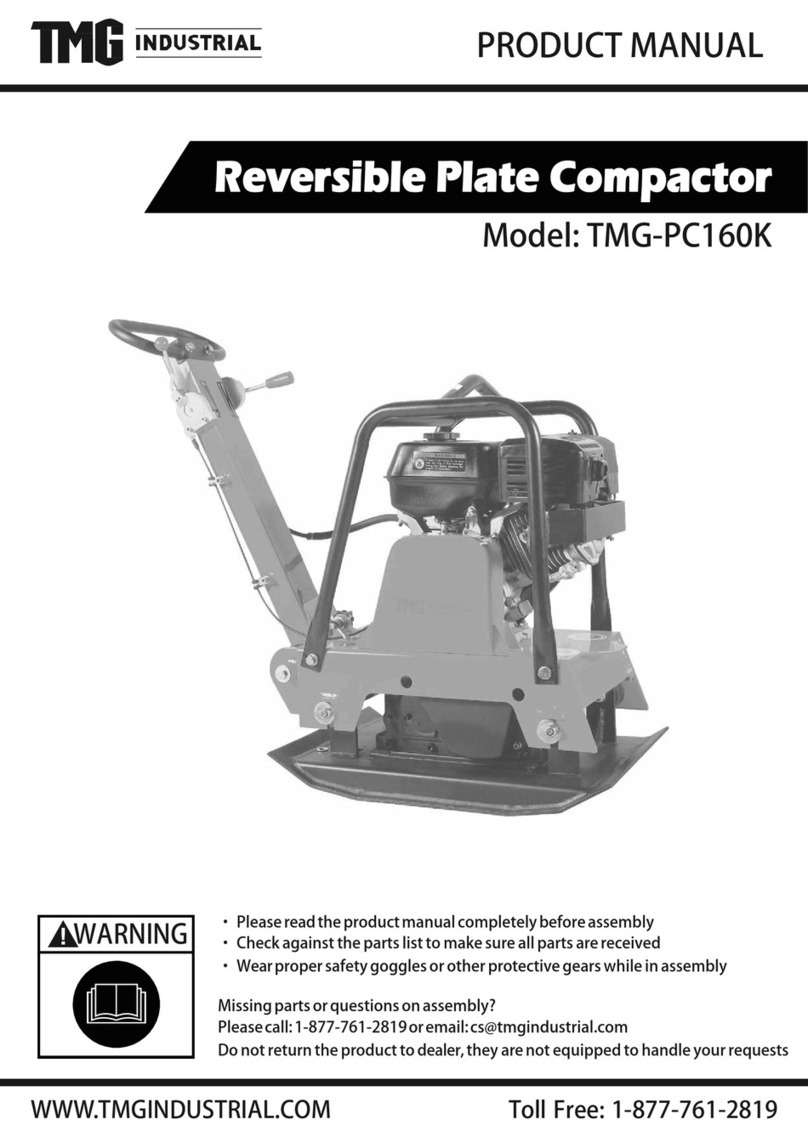
• Make sure that only approved persons are in the
work area.
• Keep the work area clean and bright.
• Make sure that you are in a safe and stable position
during operation.
• Make sure that there is no risk that you or the
product can fall from a height.
• Make sure that there is no grease or oil on the
handle.
• Do not use the product in areas where fire or
explosions can occur.
• The product can cause objects to eject at high
speed. Make sure that all persons in the work area
use approved personal protective equipment.
Remove loose objects from the work area.
• Before you go away from the product, stop the
engine and make sure that there is no risk of
accidental start.
• Make sure that clothes, long hair and jewelry do not
get caught in moving parts.
• Do not sit on the product.
• Do not hit the product.
• Always operate the product from behind with your
hands on the handle.
• Do not operate the product near electrical cables.
The product does not have electrical insulation and
injury or death can occur.
• Before you operate the product, find out if there are
hidden wires, cables and pipes in the work area. If
the product hits a hidden object, stop the engine
immediately and examine the product and the object.
Do not start to operate the product again until you
know that it is safe to continue.
Remote control safety (LH 804)
WARNING: Read the warning instructions
that follow before you use the product.
• The product can be operated by a remote control for
long distances. Do not operate the product unless
you have clear view of the product and its risk area.
Cordon off the work area to prevent injury to
bystanders.
• Do not operate the product from a longer distance
than 20 m/66 ft.
• Do not let a person operate the remote control
unless they read and understand the contents of the
operator's manual.
• Do not operate the remote control unless you
receive training before use. Make sure that all
operators receive training in the operation of the
remote control and the control system of the product.
If the operator does not know the control system,
sudden movements in the product can occur and
cause injuries.
• Before you go away from the product, stop the
engine and the remote control. Put the remote
control in the transport position behind the rear
cover. Lock the rear cover with a padlock. This
makes sure that the product cannot be used by
persons that are not approved.
• If an error occurs in the control system, push the
emergency stop button on the remote control and
disconnect the battery. Let an approved service
center repair the product.
Vibration safety
WARNING: Read the warning instructions
that follow before you use the product.
• During operation of the product, vibrations go from
the product to the operator. Regular and frequent
operation of the product can cause or increase the
degree of injuries to the operator. Injuries can occur
in fingers, hands, wrists, arms, shoulders, and/or
nerves and blood supply or other body parts. The
injuries can be debilitating and/or permanent, and
can increase gradually during weeks, months or
years. Possible injuries include damage to the blood
circulation system, the nervous system, joints, and
other body structures.
• Symptoms can occur during operation of the product
or at other times. If you have symptoms and
continue to operate the product, the symptoms can
increase or become permanent. If these or other
symptoms occur, get medical aid:
• Numbness, loss of feeling, tingling, pricking,
pain, burning, throbbing, stiffness, clumsiness,
loss of strength, changes in skin color or
condition.
• Symptoms can increase in cold temperatures. Use
warm clothing and keep your hands warm and dry
when you operate the product in cold environments.
• Do maintenance on and operate the product as
given in the operator's manual, to keep a correct
vibration level.
• The product has a vibration damping system that
decreases the vibrations from the handles to the
operator. Let the product do the work. Do not push
the product with force. Hold the product at the
handles lightly, but make sure that you control the
product and operate it safely. Do not push the
handles into the end stops more than necessary.
• Keep your hands on the handle or handles only.
Keep all other body parts away from the product.
• Stop the product immediately if strong vibrations
suddenly occurs. Do not continue the operation
before the cause of the increased vibrations is
removed.
Dust safety
WARNING: Read the warning instructions
that follow before you use the product.
61177 - 001 - 02.04.2020




































